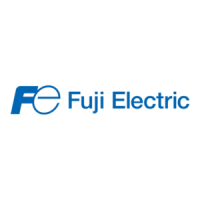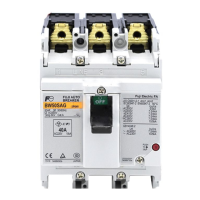Do you have a question about the Fuji Electric EW100EAG and is the answer not in the manual?
Overviews low-voltage circuit faults (overcurrent, ground, phase-loss) and protection measures.
Explains overload and short-circuit protection, including trip characteristics.
Details phase-loss faults in three-phase circuits and motor winding protection.
Describes types of overcurrent tripping (inverse, instantaneous, short-time delay) and factors affecting them.
Details how MCCBs interrupt short-circuit currents, including oscillograms and let-through values.
Specifies overload switching test conditions and performance criteria according to IEC standards.
Covers temperature rise and internal resistance/power consumption at rated current.
Outlines switching durability requirements and trip switching durability for MCCBs and accessories.
Details test circuits and criteria for power frequency and impulse withstand voltages.
Presents data on operating force and angle for various MCCB handle types.
Lists key considerations for selecting MCCBs, covering power supply, installation, application, and characteristics.
Explains conditions and criteria for cascade (backup) trip coordination between MCCBs.
Details selective trip coordination between MCCBs and with high-voltage fuses or devices.
Covers protecting wiring from overcurrents, thermal effects, and selecting protective devices.
Addresses MCCB selection for motor circuits, including starting currents and coordination.
Discusses transformer inrush current and MCCB selection for primary circuits.
Provides guidance on selecting MCCBs for arc and resistance welders, considering intermittent operation.
Covers capacitor circuit characteristics and MCCB selection to prevent arc reignition and inrush current.
Explains overcurrent causes and MCCB selection for thyristors and semiconductor devices.
Details combinations for protecting solid-state contactors (SSCs) in heater circuits.
Guides MCCB selection for inverter circuits, considering DC reactor use.
Lists MCCBs for 400Hz circuits, noting derating due to skin effect.
Covers MCCB application in DC circuits, including operating characteristics and selection.
Discusses selecting MCCBs for UPS systems, focusing on overload withstand.
Provides guidance on selecting MCCBs for servo amplifier power supply switching.
Explains grounding systems (TN, TT, IT) and ground fault protection.
Addresses MCCB use in high-temperature, cold-climate, high-altitude, and corrosive atmospheres.
Details guidelines for reversed connections and proper tightening torque for conductors.
Explains how to prevent MCCB malfunction caused by transient inrush currents.
Outlines initial and periodic inspection procedures, criteria, and environmental standards.
Provides guidelines for MCCB deterioration diagnosis, replacement timing, and switching durability.
Overviews low-voltage circuit faults (overcurrent, ground, phase-loss) and protection measures.
Explains overload and short-circuit protection, including trip characteristics.
Details phase-loss faults in three-phase circuits and motor winding protection.
Describes types of overcurrent tripping (inverse, instantaneous, short-time delay) and factors affecting them.
Details how MCCBs interrupt short-circuit currents, including oscillograms and let-through values.
Specifies overload switching test conditions and performance criteria according to IEC standards.
Covers temperature rise and internal resistance/power consumption at rated current.
Outlines switching durability requirements and trip switching durability for MCCBs and accessories.
Details test circuits and criteria for power frequency and impulse withstand voltages.
Presents data on operating force and angle for various MCCB handle types.
Lists key considerations for selecting MCCBs, covering power supply, installation, application, and characteristics.
Explains conditions and criteria for cascade (backup) trip coordination between MCCBs.
Details selective trip coordination between MCCBs and with high-voltage fuses or devices.
Covers protecting wiring from overcurrents, thermal effects, and selecting protective devices.
Addresses MCCB selection for motor circuits, including starting currents and coordination.
Discusses transformer inrush current and MCCB selection for primary circuits.
Provides guidance on selecting MCCBs for arc and resistance welders, considering intermittent operation.
Covers capacitor circuit characteristics and MCCB selection to prevent arc reignition and inrush current.
Explains overcurrent causes and MCCB selection for thyristors and semiconductor devices.
Details combinations for protecting solid-state contactors (SSCs) in heater circuits.
Guides MCCB selection for inverter circuits, considering DC reactor use.
Lists MCCBs for 400Hz circuits, noting derating due to skin effect.
Covers MCCB application in DC circuits, including operating characteristics and selection.
Discusses selecting MCCBs for UPS systems, focusing on overload withstand.
Provides guidance on selecting MCCBs for servo amplifier power supply switching.
Explains grounding systems (TN, TT, IT) and ground fault protection.
Addresses MCCB use in high-temperature, cold-climate, high-altitude, and corrosive atmospheres.
Details guidelines for reversed connections and proper tightening torque for conductors.
Explains how to prevent MCCB malfunction caused by transient inrush currents.
Outlines initial and periodic inspection procedures, criteria, and environmental standards.
Provides guidelines for MCCB deterioration diagnosis, replacement timing, and switching durability.
| Brand | Fuji Electric |
|---|---|
| Model | EW100EAG |
| Category | Circuit breakers |
| Language | English |










